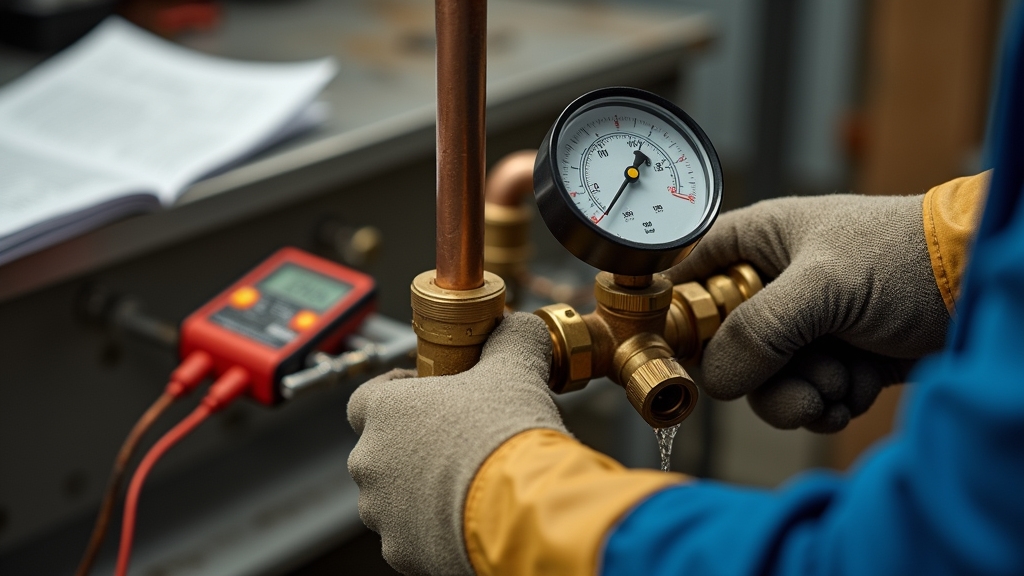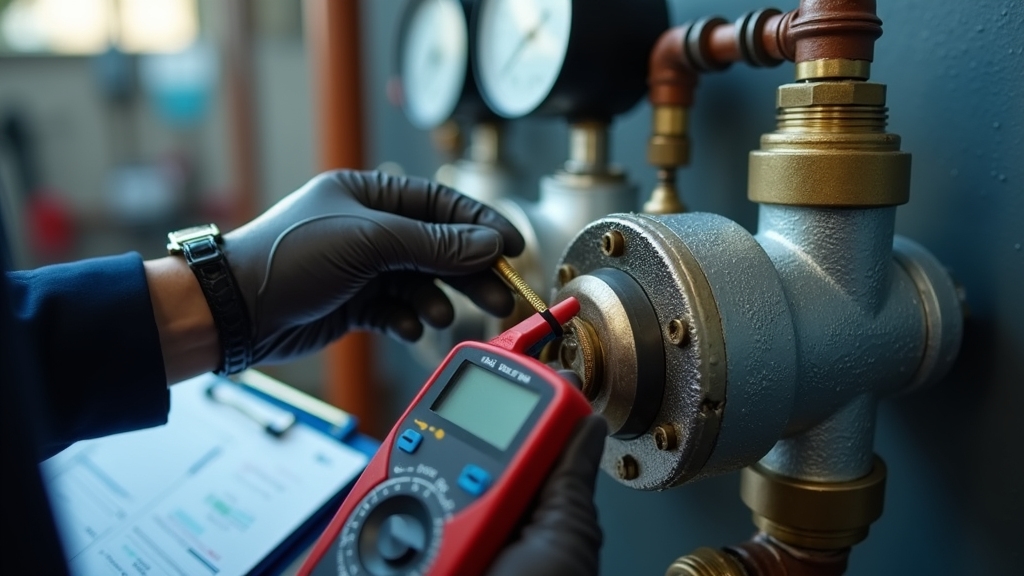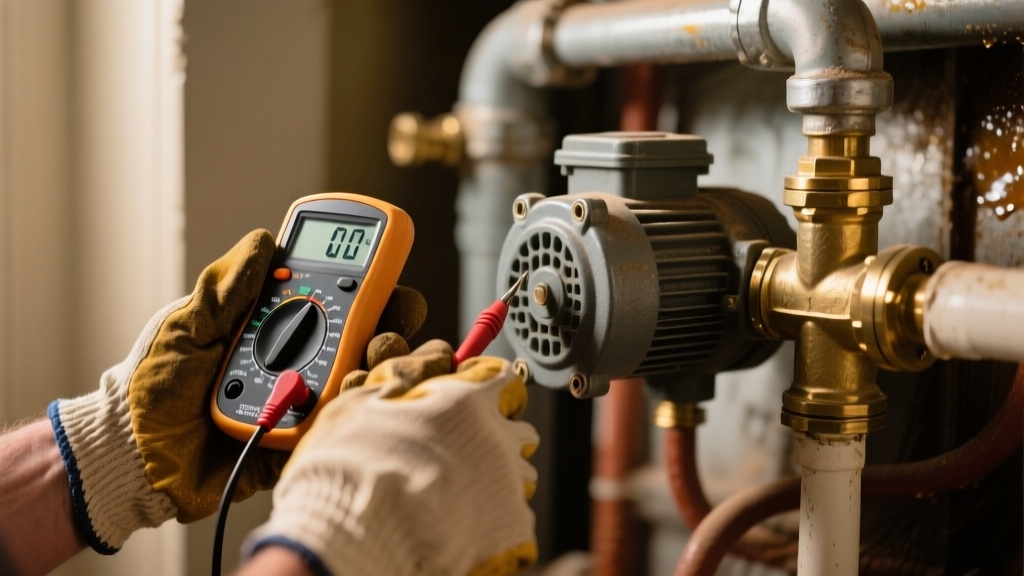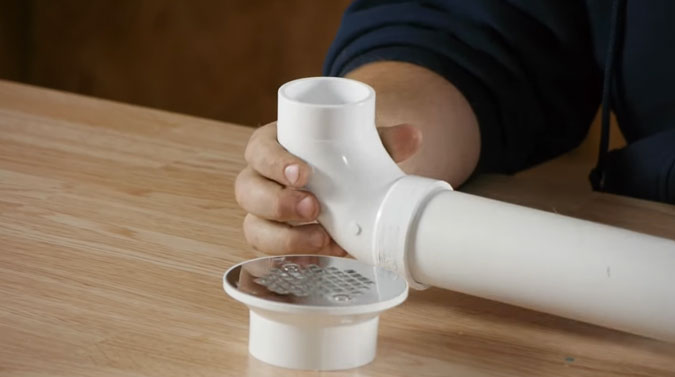To test your circulator pump, start by visually inspecting for leaks, proper alignment, and secure mounting. Verify electrical components and motor rotation with appropriate tools. Measure flow rates using calibrated flow meters and confirm pressure against the pump curve.
Check inlet and outlet temperatures to assess Delta T and detect anomalies. Use vibration and acoustic sensors for mechanical faults, and thermographic imaging to identify overheating.
Follow strict safety protocols throughout. Understanding these steps ensures accurate diagnostics and ideal pump performance; further techniques refine this process efficiently.
Key Takeaways
- Inspect pump visually for leaks, motor condition, proper rotation, and secure mounting before testing.
- Measure flow rate and pressure using calibrated flow meters and differential pressure gauges, comparing results to pump curves.
- Verify motor electrical parameters including voltage, current, winding resistance, and correct phase rotation with appropriate meters.
- Monitor temperature differentials across the pump and check for abnormal noise or vibration using accelerometers and acoustic tools.
- Follow safety protocols: disconnect power, lockout/tagout, wear PPE, and ensure proper fluid handling during testing.
Understanding the Purpose of Circulator Pump Testing

You rely on the pump to maintain steady fluid flow within a closed loop, ensuring consistent pressure, temperature, and efficient heat transfer. Installing a proper check valve in the system helps maintain this flow by preventing backflow when the pump is off.
Testing confirms the pump meets its design specifications for flow rate, head pressure, and power consumption, which directly impacts system efficiency and reliability. Without proper testing, you risk undetected mechanical or electrical faults like impeller damage or motor burnout that degrade performance and cause costly downtime.
Testing also identifies flow irregularities and seal leaks that compromise system integrity. Regular pump testing supports maintenance planning and operational reliability by identifying potential issues early to prevent failures.
By verifying operation within safe parameters, you preserve system longevity, reduce energy costs, and uphold maintenance standards. In short, pump testing is a critical diagnostic step to sustain ideal circulation and prevent performance degradation.
Preparing the System for Accurate Testing
Before you begin testing a circulator pump, you must prepare the system thoroughly to guarantee accurate and reliable measurements.
Start by shutting down power and verifying that all electrical components, including cables, protective devices, and grounding, function correctly. Ensuring a stable power source is crucial for consistent pump performance.
Inspect the pump housing and piping for leaks. Prime the pump to prevent dry running, and open all isolation valves fully. Confirm pump rotation matches the directional arrow. Remove air locks via bleeding to ensure consistent temperature control.
Secure the pump to minimize vibration during operation. Calibrate and set up instruments to measure flow rate, head, current, and voltage precisely. Fill the system with fluid, conduct hydrostatic leak tests, and monitor for abnormal noise or vibration while gradually pressurizing.
Conducting Flow Verification Procedures

When verifying flow through a circulator pump, you’ll rely on precise measurements of differential pressure and flow rates to assess performance accurately.
Begin by installing a differential pressure gauge across the pump’s suction and discharge sides, comparing readings with the manufacturer’s pump curve to estimate flow. Correct for any inlet-to-outlet diameter differences to refine accuracy. Prior to testing, ensure a clean workspace to maintain measurement integrity and safety.
Supplement this with calibrated flow meters, either permanent or ultrasonic clamp-on, to independently verify flow. Cross-check these data sets to identify discrepancies indicating pump or system issues. It is important to use calibrated gauges for accurate measurements, as uncalibrated instruments can lead to misleading conclusions.
Additionally, confirm check valve operation during start-stop tests, listening for proper seating sounds to prevent backflow. Verify motor rotation with phase rotation tools, as incorrect rotation reduces differential pressure and flow by roughly 30%.
Performing Temperature Checks on the Pump System
Accurate flow verification relies not only on pressure and flow rate measurements but also on evaluating temperature differentials across the circulator pump system.
Start by measuring temperatures at both the inlet and outlet pipes using an infrared thermometer or manual touch to determine the Delta T. This temperature difference reveals flow quality and heat transfer efficiency. It is important to check if the circulator pump is running when the thermostat calls for heat to confirm the pump is operating as expected pump operation check.
Additionally, understanding the directionality of valves in the system can impact flow patterns and temperature readings. A typical Delta T ranges from 5-7°C for heat pumps to about 20°C for gas boilers. If inlet and outlet temperatures equalize, or if pipes remain uniformly hot with no variation, the pump may be seized or non-circulating.
Look for sudden downstream temperature drops, indicating leaks or insulation failures. Consistently monitor pump housing and adjacent pipe temperatures to ensure components operate within safe thermal limits, preventing overheating and mechanical failure.
Assessing Motor Function and Electrical Parameters
Although temperature and flow assessments provide valuable insights, evaluating motor function and electrical parameters is critical for diagnosing circulator pump performance issues. You must verify correct motor rotation by measuring differential pressure and listening for discharge valve sounds.
Performing these checks during initial startup or after installation is essential to prevent motor damage or failure due to reverse rotation. Additionally, regular inspection and maintenance can prevent potential valve issues that might affect pump performance.
Monitor motor amperage with a clamp-on ammeter; abnormal amps often indicate rotation errors or mechanical binding. Measure winding resistance using a multimeter. Values outside 120 Ω to 250 Ω suggest winding faults. Confirm rated voltage supply at motor terminals before proceeding.
Integrate mechanical checks like manual shaft rotation with electrical tests for exhaustive diagnostics.
| Parameter | Normal Range | Warning Signs |
|---|---|---|
| Motor Rotation | Forward | High amps, reversed flow |
| Winding Resistance | 120–250 Ω | <100 Ω or infinite (burnt windings) |
| Supply Voltage | Rated voltage (e.g., 240 V) | Voltage absence at terminals |
| Motor Current (Amps) | Design specs | Elevated or locked rotor current |
Visual Inspection Techniques for Detecting Issues
Since visual inspection provides immediate clues about a circulator pump’s condition, you should systematically examine external housing, internal components, lubrication systems, alignment, and flow connections.
Start by inspecting the pump casing for cracks, corrosion, or deformation, and check seals and gaskets for leakage. Internal supports or baffles may break off over time, so look for any signs of damage or loose parts inside the pump to ensure pump safety.
Additionally, contamination from untreated water sources can accelerate corrosion and mechanical wear. Use a borescope to assess impeller blades for damage, erosion, or sediment buildup. Observe oil clarity and desiccant breather indicators to evaluate lubricant health and detect moisture ingress.
Verify shaft alignment visually and inspect mounting hardware for looseness or corrosion. Finally, examine suction and discharge piping for leaks, temperature anomalies, and signs of cavitation or clogging.
Failure to address these issues promptly can lead to environmental consequences such as contamination of surrounding water bodies. This targeted approach helps you identify mechanical or hydraulic issues early, supporting accurate diagnostics and preventing premature pump failure.
Utilizing Acoustic and Vibration Analysis Methods
When you apply acoustic and vibration analysis to circulator pumps, you gain a powerful means to detect faults that aren’t visible through inspection alone.
By measuring both fluid-borne and structure-borne acoustic emissions, you capture extensive data reflecting pump conditions. Recirculating pumps, unlike tankless water heaters, operate continuously or on a schedule, which can influence the vibration patterns detected during analysis.
Utilize tri-axial accelerometers on the casing to identify translational and rotational vibrations, isolating mechanical issues like bearing wear or impeller imbalance.
Employ acoustic microphones near fluid outlets to detect flow-induced noise and cavitation. Analyzing these noises is crucial since recirculating pumps may consume more energy due to continuous operation, making early fault detection important for energy efficiency.
Analyzing complex multiphase flow patterns and their associated acoustic noise generation can enhance interpretation of pump noise data.
Analyze frequency spectra to differentiate between mechanical faults and fluid dynamic instabilities. Methods like the reception plate and free velocity tests simulate real-world mounting and isolate pump sources.
Continuous monitoring lets you track changes in vibration amplitude and mode shapes, enabling early detection of misalignment, looseness, or cavitation before they escalate into failures. This approach is especially beneficial given that regular maintenance is essential to sustain the efficiency and longevity of circulator pumps.
Applying Thermographic Testing for Overheating Detection
By applying thermographic testing, you can accurately detect overheating in circulator pumps before it leads to mechanical failure. Use an infrared camera to capture thermal images of key components, such as motor bearings, rotor assemblies, and shaft couplings, while the pump operates under normal load.
Capture thermal images of motor bearings, rotor assemblies, and shaft couplings during normal pump operation using an infrared camera. These images reveal heat anomalies through color-coded maps, signaling lubrication issues, mechanical wear, or electrical faults.
Make certain camera calibration accounts for pump material emissivity to enhance accuracy. Regularly compare scans against baseline images or manufacturer standards to detect subtle temperature rises. Remember, thermography measures surface temperature, so corroborate findings with mechanical or electrical assessments.
This non-contact, non-destructive method enables early fault detection, minimizes unplanned downtime, and extends pump life by guiding timely maintenance interventions. For best results, ensure inspections are performed by trained and certified technicians to accurately interpret thermal images and avoid false positives.
Additionally, maintaining balanced pump operation helps prevent overheating and ensures system longevity.
Ensuring Safety During Testing Procedures
Although testing a circulator pump is essential for maintenance, you must prioritize safety to prevent electrical shock, mechanical injury, or equipment damage. Start by disconnecting power at the main breaker and verifying zero voltage with a multimeter.
Implement lockout/tagout procedures to ensure power remains isolated during testing. Secure piping and supports to avoid strain and inspect for leaks or damage. Always wear appropriate PPE, including insulated gloves and safety glasses, and avoid loose clothing.
| Safety Aspect | Key Actions |
|---|---|
| Electrical Isolation | Disconnect power, verify zero voltage, lockout/tagout |
| Mechanical Handling | Secure supports, inspect for leaks, use proper tools |
| PPE Requirements | Wear insulated gloves, safety glasses, avoid loose items |
| Pressure Management | Adhere to pressure limits, inspect seals, clear moving parts |
Additionally, understanding the importance of water level regulation in related systems like swamp coolers can help prevent potential water damage during maintenance.
Scheduling Regular Maintenance and Testing Intervals
To ensure your pump runs smoothly, it’s important to figure out how often you should test it based on its type and how it’s being used. This way, you can catch any potential issues before they turn into major problems.
Keeping a regular schedule for inspections and testing after repairs is crucial. It helps confirm that everything is working as it should and that the system is back to its optimal performance.
Maintenance schedules should be based on factors impacting pump health, including pump quality, usage frequency, and environmental impacts, to optimize preventive maintenance. Battery age and battery capacity also play a significant role in determining appropriate testing intervals.
Also, don’t forget to keep a record of everything! Documenting your maintenance results can be really helpful. It allows you to spot trends and make necessary adjustments to your testing intervals, especially when you consider different environmental factors.
Critical Pump Testing Frequency
How often should you test critical circulator pumps to guarantee they remain dependable under operational demands? Generally, critical pumps require quarterly testing to confirm operational readiness and prevent failures.
Fire pumps mandate weekly churn tests and annual full flow evaluations to ensure performance aligns with original acceptance criteria. Testing frequency hinges on pump type, system criticality, and regulatory mandates like NFPA 25, which specifies weekly or monthly no-flow tests and annual comprehensive assessments. Regular testing also ensures fire pumps are in proper working order, fulfilling legal responsibilities.
Operating conditions and risk profiles further dictate intervals. Continuous-use or high-risk facilities demand more frequent verification. Weekly tests also include visual inspections for leaks, vibrations, and packing conditions to catch early anomalies.
Documenting and adhering to these intervals supports compliance and minimizes downtime, providing a structured approach to maintaining pump reliability under varying operational stresses.
Maintenance Schedule Importance
Regular testing intervals establish a foundation for pump reliability, but maintaining consistent performance demands a well-structured maintenance schedule. You should integrate preventive maintenance tasks daily, monthly, and quarterly to inspect critical components like seals, bearings, and gaskets, alongside lubrication and vibration checks.
Tailoring these intervals based on environmental factors such as temperature extremes, humidity, and exposure to corrosive agents guarantees ideal pump longevity. Including routine procedures such as checking the bearing temperature and lubricant condition helps predict and prevent potential failures early.
Daily visual and temperature inspections catch early anomalies, while quarterly alignment and oil replacement prevent mechanical degradation. Avoid relying solely on corrective maintenance, which risks prolonged downtime. Instead, combine scheduled inspections with monitoring maintenance techniques to anticipate failures proactively.
Adhering to this regimented schedule enhances operational efficiency, reduces unexpected failures, and extends the circulator pump’s service life through systematic, data-driven maintenance.
Post-Repair Testing Guidance
Although repairs restore immediate functionality, scheduling operational tests within 24 to 48 hours post-repair is critical to confirm the pump operates correctly without leaks or abnormal noises.
Run the pump through a full cycle to verify flow rate and system pressure meet specifications and observe temperature differentials for proper function. This helps ensure that the consistent hot water flow generated by the motor is maintained throughout the system.
Conduct weekly follow-up tests during the first month to identify latent issues like electrical faults or seal failures. Establish regular maintenance intervals, typically every six months, adjusting frequency for heavy usage or adverse conditions.
Include electrical checks, manual impeller rotation, seal inspections, and vibration measurements in each session. Document all results precisely, noting deviations to enable predictive maintenance. Use condition-based monitoring data when available to optimize test frequency, ensuring continued pump reliability and early detection of performance degradation.
Frequently Asked Questions
Can I Test a Circulator Pump Without Shutting Down the Heating System?
Yes, you can test a circulator pump without shutting down the heating system. Locate the pump while the system runs, feel for warming pipes, listen for operational sounds, and check for leaks or corrosion.
Use temperature and flow indicators to assess circulation. You can briefly cut power to inspect the pump shaft manually and measure electrical parameters safely. Bleed air pockets by opening the bleed screw with the pump power off, maintaining system integrity without full shutdown.
What Are the Signs of a Failing Circulator Pump Motor?
Imagine your circulator pump motor as a medieval knight sounding battle drums; if you hear grinding, clanking, or squealing, it’s signaling bearing or motor issues. You’ll notice inconsistent heating, uneven radiator warmth, or no heat at all.
Watch for leaks or corrosion around the pump, and check for electrical faults like failure to start or abnormal current draw. Excessive vibration or locked bearings also indicate motor failure. Act swiftly to avoid total breakdown.
How Do Ambient Temperature Changes Affect Pump Testing Results?
You’ll find ambient temperature changes directly influence pump testing results by altering air density, fluid viscosity, and pressure conditions. Higher temperatures reduce pump efficiency and power output, while lower temperatures can improve power but risk operational issues like increased wear.
Temperature fluctuations also affect thermal expansion in components, potentially skewing performance data. To get accurate results, you need to compensate for these variations by calibrating sensors and considering environmental factors during testing.
Is It Necessary to Recalibrate Testing Tools Regularly?
Yes, you need to recalibrate testing tools regularly. Calibration drifts over time due to factors like ambient temperature changes and supply voltage variations, which can skew your measurements.
By recalibrating every 4 to 6 months, you maintain accuracy, reliability, and compliance with standards. This prevents costly errors, ensures data integrity, and optimizes system performance. Skipping recalibration risks compromised results and inefficient operation, so stay proactive with scheduled maintenance.
Can Water Quality Impact Circulator Pump Performance and Testing?
Yes, water quality can reduce circulator pump efficiency by up to 15% due to scale and corrosion buildup. You’ll notice this decreases hydraulic performance and skews flow rate measurements during testing. Contaminants cause sensor fouling, requiring you to apply correction factors for accuracy.
Poor water quality also accelerates wear on seals and bearings, increasing maintenance frequency and operating costs. Always guarantee clean, chemically neutral water for reliable pump testing and longevity.
From Vibration Analysis to Flow Checks: Keep Your Pump Running Strong
By regularly testing your circulator pump, you guarantee peak performance and prevent costly failures. For example, a commercial building in Chicago avoided a major heating shutdown by detecting early motor wear through vibration analysis.
You’ll want to verify flow rates, check temperatures, and analyze electrical parameters systematically. Following precise testing protocols not only extends pump life but also maintains system efficiency. Make safety your priority and schedule routine maintenance to catch issues before they escalate.


